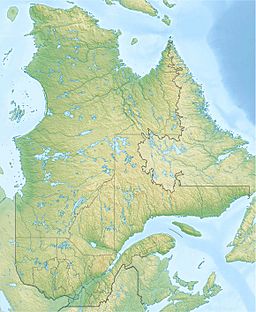Long Lake (Saint-Alban) facts for kids
Quick facts for kids Long Lake |
|
|---|---|
| Location | Saint-Ubalde, Portneuf Regional County Municipality, Capitale-Nationale, Quebec, Canada |
| Coordinates | 46°50′14″N 72°08′23″W / 46.83722°N 72.13972°W |
| Lake type | Natural |
| Primary inflows | (Clockwise from the mouth) Discharge from Caribou Lake, discharge from two unidentified small lakes, discharge from three unidentified small lakes, discharge from Nadeau Lake, Noire River, discharge from a group of lakes including Lac à Gougeon, Le Gros Lac, Lac Travers, Lac La Salle, Lac Damas, Lac des Îles, Lac Lépine and Lac No name, discharge from an unidentified small lake. |
| Primary outflows | Noire River |
| Basin countries | Canada |
| Max. length | 6.7 km (4.2 mi) |
| Max. width | 1.6 km (0.99 mi) |
| Surface area | 3 km2 (1.2 sq mi) |
| Surface elevation | 176 m (577 ft) |
Long Lake is a beautiful lake in Quebec, Canada. It is located entirely within the municipality of Saint-Alban. The Noire River flows right through it.
The area around Long Lake is mostly forest. People here work in forestry, which means they manage forests and harvest trees. Tourism is also important, as many visitors come to enjoy the lake and its surroundings.
If you visit in winter, you'll find the lake frozen! It usually freezes from early December to late March. It's generally safe to walk or play on the ice from mid-December to mid-March.
About Long Lake
Long Lake is quite long and narrow. It stretches for about 6.7 kilometres (4.2 mi) and is up to 1.6 kilometres (0.99 mi) wide. It lies in a southeast direction, surrounded by thick forests.
The lake has several bays. On its southwest side, there are four bays. One of these bays receives water from Lac Nadeau. On the northeast side, there are two bays. One gets water from a small, unnamed lake. The other bay collects water from a group of lakes, including Lac à Gougeon, Le Gros Lac, Lac Travers, Lac La Salle, Lac Damas, Lac des Îles, Lac Lépine, and Lac No name.
Portneuf Regional Natural Park
Long Lake is part of the amazing Portneuf Regional Natural Park. This park covers about 70 kilometres (43.50 mi) and includes many other lakes like Montauban, Carillon, Sept Îles, and Lac en Cœur. The park is a popular spot for outdoor activities. You can go hiking on its trails or launch your boat into the water.
Where Does the Water Go?
The water from Long Lake flows out from its southeast end. The Noire River is the lake's main outflow. This river winds its way through the plain of Saint-Laurent until it reaches the village of Saint-Casimir.
From Long Lake, the water travels:
- About south along the Noire River.
- Then, about 11.5 kilometres (7.1 mi) south along the Sainte-Anne River.
- Finally, the Sainte-Anne River flows into the mighty Saint-Laurent River.
What's in a Name?
The name "Lac Long" (which means "Long Lake" in French) has been used for a very long time. It first appeared on a map of the Montauban area in 1902. Most maps since then have used the same name.
It's not surprising that many places in Quebec are called "Long" or "Longue" (the feminine form of long). There are over 200 such places! This is because the name describes their shape – they are long. In Indigenous languages, similar names like Kinogami or Kachinukamach also mean "long."
Historically, people have used the word "long" in place names for centuries. For example, in 1604, explorer Samuel de Champlain recorded an "isle Longue" (Long Island). In 1634, a Jesuit report mentioned "in Long Sault" (Long Rapids) on the Outaouais River.
Today, most places named "Long" are lakes. There are more than 160 "Long Lakes" across Quebec! Sometimes, a lake originally called "Long" might get a new name, like Chopin Lake or Bienville Lake. Other times, new names might still describe its shape, using words like "Elongé" (elongated) or "Étroit" (narrow).
The official name "Lac Long" was made formal on December 5, 1968, by the Commission de toponymie du Québec, which is the organization in charge of place names in Quebec.


